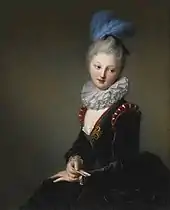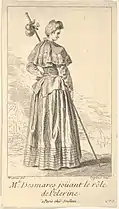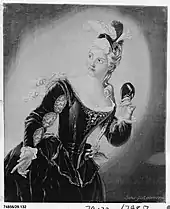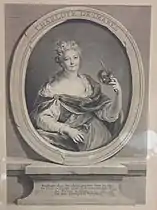Charlotte Desmares
Christine Antoinette Charlotte Desmares (1682 – 12 September 1753) was a French actress. She was known as la Desmares and also nicknamed Lolotte. She was the elder sister of the fellow actress Catherine Dangeville.
Charlotte Desmares | |
|---|---|
.jpg.webp) Copy after Charles-Antoine Coypel, Charlotte Desmares, oil on canvas, Comédie-Française, Paris[lower-alpha 1] | |
| Born | Christine Antoinette Charlotte Desmares 1682 Copenhagen, Denmark |
| Died | September 12, 1753 Saint-Germain-en-Laye, France |
| Occupation | actress |
| Years active | 1699–1721 |
| Organization | Comédie-Française |
| Children | 3, including Philippe Angélique de Froissy |
| Parents |
|
| Relatives | Catherine Dangeville (sister) Marie Champmeslé (aunt) |
Life
She was born in Copenhagen to the comic actors Nicolas Desmares and Anne d'Ennebault and trained under her aunt la Champmeslé. She made her stage début aged sixteen with the Comédie-Française company on 30 January 1699 in Oreste et Pylade by Lagrange-Chancel. In only three months she became so successful that she was accepted as a sociétaire of the company to replace her aunt, who had left it in 1698. Like her aunt she played tragic roles (such as Hermione in Andromaque by Jean Racine, Émilie in Cinna by Pierre Corneille, and Jocasta in Oedipus by Voltaire[1]) as well as comedy ones (such as Lisette in Le Légataire universel by Regnard and Néréine in Le Curieux impertinent by Destouches). She retired in 1721.[2]
She became mistress to Louis, Grand Dauphin then to Philippe II, Duke of Orléans, with whom she had a daughter in 1700, named Angélique de Froissy by her father and married off to count Henri François de Ségur.[3] Desmares ended her life as the mistress of the Swiss banker Antoine Hogguer, who built the Hôtel de Villeroy, designed by François Debias-Aubry, for her in Paris at 78 Rue de Varreau.[4][5] She also built herself the 'Folie Desmares' in Châtillon, which still survives.[6] She died in Saint-Germain-en-Laye in 1753.
Gallery
- Artworks presumed to be depictions of Desmares
 Attributed to Jean-Baptiste Santerre, Portrait of a Young Lady with a Letter, 1700s, oil on canvas, private collection[7][lower-alpha 2]
Attributed to Jean-Baptiste Santerre, Portrait of a Young Lady with a Letter, 1700s, oil on canvas, private collection[7][lower-alpha 2]_(14577741349).jpg.webp) Attributed to Jean Raoux, Portrait de Mlle Desmares, oil on canvas, formerly in the collection of Arsène Houssaye[12]
Attributed to Jean Raoux, Portrait de Mlle Desmares, oil on canvas, formerly in the collection of Arsène Houssaye[12].jpg.webp) Antoine Watteau, detail of Love in the French Theatre, ca. 1715–1716, oil on canvas, Gemäldegalerie, Berlin[13]
Antoine Watteau, detail of Love in the French Theatre, ca. 1715–1716, oil on canvas, Gemäldegalerie, Berlin[13].jpg.webp) Antoine Watteau, detail of Fêtes Vénitiennes, ca. 1718–1719, oil on canvas, National Galleries of Scotland, Edinburgh[lower-alpha 3]
Antoine Watteau, detail of Fêtes Vénitiennes, ca. 1718–1719, oil on canvas, National Galleries of Scotland, Edinburgh[lower-alpha 3].jpg.webp) Antoine Watteau, detail of Actors of the Comédie-Française (also known as Coquettes qui pour voir), between 1711 and 1718, oil on panel, Hermitage Museum, Saint Petersburg[lower-alpha 4]
Antoine Watteau, detail of Actors of the Comédie-Française (also known as Coquettes qui pour voir), between 1711 and 1718, oil on panel, Hermitage Museum, Saint Petersburg[lower-alpha 4]

 Louis Desplaces after Antoine Watteau, Mlle Desmares joüant le rôle de Pelerine, ca. 1710–1739, etching, Metropolitan Museum of Art, New York City[26][27]
Louis Desplaces after Antoine Watteau, Mlle Desmares joüant le rôle de Pelerine, ca. 1710–1739, etching, Metropolitan Museum of Art, New York City[26][27]
 François-Bernard Lépicié after Charles-Antoine Coypel, Portrait of Charlotte Desmares, 1733, etching
François-Bernard Lépicié after Charles-Antoine Coypel, Portrait of Charlotte Desmares, 1733, etching
Notes
- For further discussion of Coypel's portrait of Desmares and related pictures, see Lefrançois, Thierry (1994). Charles Coypel: Peintre du Roi : 1694-1752 (in French). Preface by Pierre Rosenberg. Paris: Arthéna. pp. 182–183, cat. no. P.40. ISBN 2-903239-18-5. OCLC 231852472.
- There are several versions of Santerre's painting, notably those in Paris at the Comédie Française[8][9] and in Boston at the Museum of Fine Arts.[10][11]
- In numerous works on 18th-century French art, British art historian Michael Levey associated the female dancer in the centre of Fêtes Vénitiennes with Desmares.[14][15] Though accepted by some authors,[16][17][18]:53 Levey's point was criticised as unfounded by Andreas W. Vetter.[19]
- In an 1896 article published in Gazette des Beaux-Arts, the French playwright and poet Gaston Schéfer suggested from François-Bernard Lépicié's etching of Charles-Antoine Coypel's portrait that the woman on the left of Coquettes qui pour voir is a depiction of Desmares.[20]:185–186 In 1950, the same conclusion was given by the Louvre staff curator Hélène Adhémar, who compared the Hermitage painting with a figure in The Embarkation for Cythera, notably related to Florent Carton Dancourt's play The Three Cousins that was believed to feature Desmares as Colette, a pilgrim.[21] Coming from Adhemar's point, the Hermitage staff curator Inna Nemilova also identified the character as Desmares, and related her to similar characters in several works by Watteau, including The Island of Cythera (The Embarkation’s preceding work, now in the Städel, Frankfurt), The Dreamer (now in the Art Institute of Chicago), The Polish Woman (traditionally attributed to Watteau; now in the National Museum, Warsaw), and the lost La Polonnoise engraved by Michel Aubert.[22] Although questioned by some Watteau scholars,[23][24] Nemilova's attribution remains adopted by Russian and some Western authors.
References
- Pearson, Roger (2005). Voltaire Almighty: A Life in Pursuit of Freedom. New York: Bloomsbury. p. 54. ISBN 1-58234-630-5. OCLC 1036919317 – via the Internet Archive.
- Lancaster 1950, p. 13.
- Pevitt 1997, pp. 52, 55, 231.
- Kalnein, Wend von (1995). Architecture in France in the Eighteenth Century. New Haven: Yale University Press. p. 53. ISBN 0-300-06013-0 – via the Internet Archive.
- Pons, Bruno (1996). "Debias-Aubry, François". In Turner, Jane (ed.). The Dictionary of Art. 8. pp. 589–590. ISBN 1884446000. OCLC 1033653438 – via the Internet Archive.
- Delbos, Claire; et al. (2011). Île-de-France: Paris et environs (in French). Paris: Nouvelles éd. de l'Université. p. 294. ISBN 9782746930544. OCLC 1204326341 – via the Internet Archive.
- Lesné, Claude; Waro, Françoise (2011). Jean-Baptiste Santerre: 1651-1717 (in French). Saint-Ouen-l'Aumône: Éditions du Valhermeil. p. 81. ISBN 978-2-35467-088-7. OCLC 1194420634 – via the Internet Archive.
- Monval, Georges (1897). Les Collections de la Comédie-Française; catalogue historique et raisonné. Paris: Société de propagation des livres d'art. p. 87, cat. no. 188. OCLC 1048240692 – via the Internet Archive.
- Dacier, Émile (1905). Le musée de la Comédie-Française, 1680-1905. Paris: Librairie de l'art ancien et moderne. p. 163. OCLC 1931000 – via the Internet Archive, presumes the painting to be a fancy picture, and attributes it to Jean Raoux.
- Museum of Fine Arts, Boston (1985). European Paintings in the Museum of Fine Arts, Boston: an Illustrated Summary Catalogue. Boston, Mass: Museum of Fine Arts. p. 259. ISBN 0-87846-230-9 – via the Internet Archive.
- Standen, Edith Appleton (1985). European Post-medieval Tapestries and Related Hangings in the Metropolitan Museum of Art. 1. New York: Metropolitan Museum of Art. pp. 376–378. ISBN 0-87099-406-9.
- Hôtel Drouot, Paris (1896). Catalogue des tableaux, pastels, dessins, miniatures, sculptures, objets d'art de la galerie de M. Arsène Houssaye. Paris: Hôtel Drouot. p. 45, cat. no. 91. OCLC 1084967636 – via the Internet Archive.
- Hagen, Reiner; Hagen, Rose-Marie (2003) [2000]. What Great Paintings Say. 1. Köln, New York: Taschen. p. 282. ISBN 3-8228-2100-4 – via the Internet Archive.
- Levey, Michael (1966). Rococo to Revolution: Major Trends in Eighteenth-Century Painting. London: Thames and Hudson. pp. 76–77. OCLC 1036855531 – via the Internet Archive.CS1 maint: ref=harv (link)
- Kalnein, Wend Graf; Levey, Michael (1972). Art and Architecture of the Eighteenth Century in France. Harmondsworth: Penguin Books. pp. 20, 360 n. 33. OCLC 1008263215. SBN 14-056037-8.
- Bryson, Norman (1981). Word and Image: French Painting of the Ancien Régime. Cambridge, New York: Cambridge University Press. pp. 67–68. ISBN 0-521-27654-3 – via the Internet Archive.
- Clarke, Michael, ed. (2000). A Companion Guide to the National Gallery of Scotland. Edinburgh: National Galleries of Scotland. p. 118. ISBN 9781903278116. OCLC 1148620386 – via the Internet Archive.
- Macmillan, Duncan (Autumn 1999). "The iconography of moral sense: Gavin Hamilton's sentimental heroines". The British Art Journal. 1: 46–55. JSTOR 41615351.
- Vetter, Andreas W. (2005). …von sanften Tönen bezaubert!: Antoine Watteau – «Venezianische Feste» (exhibition catalogue) (in German). Braunschweig: Herzog Anton-Ulrich Museum. p. 25. ISBN 3-922279-61-9.
- Schéfer, Gaston (September 1896). "Les Portraits dans l'oeuvre de Watteau". Gazette des Beaux-Arts (in French) (471): 177–189 – via the Internet Archive.CS1 maint: ref=harv (link)
- Adhémar, Hélène (1950). Watteau; sa vie, son oeuvre (in French). Includes "L’univers de Watteau", an introduction by René Huyghe. Paris: P. Tisné. p. 119. OCLC 853537.
[…] tandis que Mlle Desmares, coiffée d'un grand bonnet d'orientale, figure dans les Coquettes; elle aurait prête aussi ses traits à la figure centrale de L'Embarkment.
CS1 maint: ref=harv (link) - Nemilova, I. S. (1964). Ватто и его произведения в Эрмитаже (Watteau et son œuvre à l'Ermitage) [Watteau and His Works in the Hermitage] (in Russian). Leningrad: Sovetskiy hudozhnik. pp. 86–87, 91, 181–182. OCLC 67871342.CS1 maint: ref=harv (link)
- German, M. Y. (2010) [first published in 1980]. Антуан Ватто [Antoine Watteau] (in Russian). Moscow: Iskusstvo—XXI vek. pp. 104–107. ISBN 978-5-98051-067-1. OCLC 641954308.CS1 maint: ref=harv (link)
- Grasselli, Margaret Morgan; Rosenberg, Pierre; Parmantier, Nicole; et al. (1984). Watteau, 1684-1721 (PDF) (exhibition catalogue). Washington: National Gallery of Art. pp. 305, 312. ISBN 0-89468-074-9. OCLC 557740787 – via the National Gallery of Art archive.CS1 maint: ref=harv (link)
- Germann, Jennifer Grant (2016) [2015]. Picturing Marie Leszczinska (1703-1768): Representing Queenship in Eighteenth-Century France. New York, London: Routledge. pp. 184, 196 n. 101. ISBN 9781409455820. OCLC 1001961409.
- Lescure 1861, p. 23.
- Lauterbach, Iris (2008). Antoine Watteau, 1684-1721. Back to Visual Basics. Köln: Taschen. p. 56. ISBN 978-3-8228-5318-4. OCLC 1164836547 – via the Internet Archive.
- Breck, Joseph (December 1929). "A Tapestry Portrait". The Metropolitan Museum of Art Bulletin. 24 (12): 313, 318. JSTOR 3255965.
Further reading
- Alis, Bernard (2014). Mademoiselle Desmares de la Comédie-Française (in French). Châtillon: les Amis du vieux Châtillon. ISBN 978-2-9513219-0-8. OCLC 910889182.CS1 maint: ref=harv (link)
- Clarke, Jan (2003). "Desmares, Charlotte". In Kennedy, Dennis (ed.). The Oxford Encyclopedia of Theatre & Performance. 1. Oxford ; New York: Oxford University Press. p. 362. ISBN 0-19-860672-9 – via the Internet Archive.
- DeJean, Joan (2009). The Age of Comfort: When Paris Discovered Casual and the Modern Home Began. New York: Bloomsbury. ISBN 9781596914056. OCLC 1145770221 – via the Internet Archive.
- Lancaster, Henry Carrington (1945). Sunset: A History of Parisian Drama in the Last Years of Louis XIV, 1701–1715. Baltimore, MD: John Hopkins Press. OCLC 1151320593 – via the Internet Archive.CS1 maint: ref=harv (link)
- Lancaster, Henry Carrington (1950). French Tragedy in the Time of Louis XV and Voltaire. 1. Baltimore, MD: John Hopkins Press. OCLC 1149199512 – via the Internet Archive.CS1 maint: ref=harv (link)
- Langlois, Gilles-Antoine (1993). "La Folie-Desmares à Châtillon". Dix-Huitième Siècle. 25: 457–482 – via Persee.fr.CS1 maint: ref=harv (link)
- Lescure, M. F. A. de (1861). Les maîtresses du Régent (in French). Paris: E. Dentu. OCLC 797040364 – via the Internet Archive.CS1 maint: ref=harv (link)
- Lyonnet, Henry (1902–1908). Dictionnaire des comédiens français (in French). 1. Genève: Bibliotheque de la Revue universelle internationale illustrée. pp. 525–526 – via Gallica.CS1 maint: ref=harv (link)
- Mongrédien, Georges (1972) [1961]. Dictionnaire biographique des comédiens français du XVIIe siècle (in French). Paris: Centre national de la recherche scientifique. p. 59. OCLC 654213036 – via the Internet Archive.CS1 maint: ref=harv (link)
- Pevitt, Christine (1997). Philippe, duc d'Orleans. New York: Atlantic Monthly Press. ISBN 0-87113-695-3. OCLC 1150973261 – via the Internet Archive.CS1 maint: ref=harv (link)
- Scott, Virginia (2010). Women on the Stage in Early Modern France: 1540–1750. Cambridge, New York etc.: Cambridge University Press. ISBN 978-0-521-89675-7 – via Google Books.
External links
- (in French) Charlotte Desmares at the Comédie-Française official website
- (in French) Biographie sur le site de l’Hôtel de Villeroy